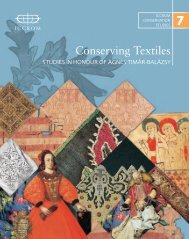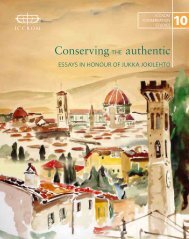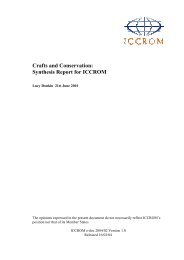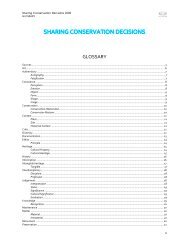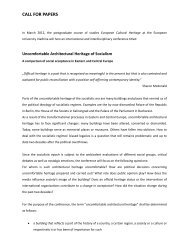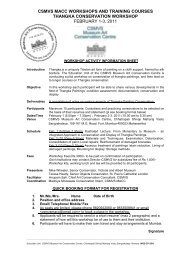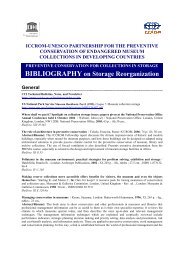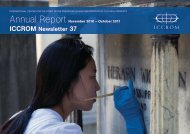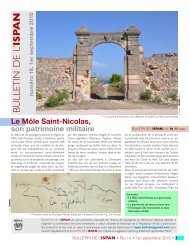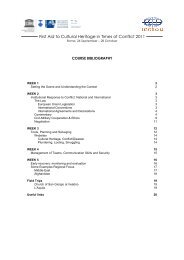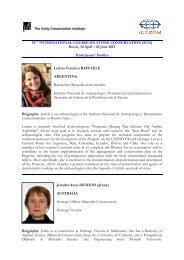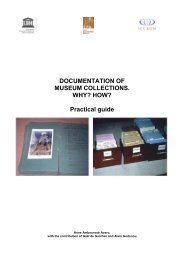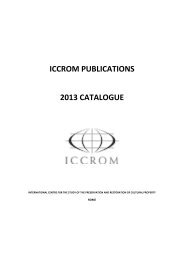part 1 - Iccrom
part 1 - Iccrom
part 1 - Iccrom
You also want an ePaper? Increase the reach of your titles
YUMPU automatically turns print PDFs into web optimized ePapers that Google loves.
MEASURING HERITAGE CONSERVATION PERFORMANCE<br />
6th International Seminar on Urban Conservation<br />
As mentioned above, heritage is considered a key<br />
factor and an identity resource in urban planning.<br />
Therefore, four action lines are defined:<br />
• Elaboration and instrumentation of a legal<br />
framework, developing specific guidelines<br />
to rule action in heritage areas and<br />
sites.<br />
• Restoration of heritage buildings, through<br />
interventions in both public and private<br />
buildings, technical and management<br />
counselling; urban subsidies and<br />
agreements.<br />
• Survey, indexing and inventory.<br />
• Disclosure and awareness, through campaigns<br />
and publications.<br />
At present, the state action proposes regulatory<br />
instruments that, on the one hand, regulate or limit<br />
actions on heritage and, on the other, prioritize the<br />
incorporation of heritage in the definition of urban<br />
landscape.<br />
5. Rosario’s Urban Code<br />
and conservation of urban<br />
architectural heritage<br />
The recent introduction into the Urban Code of<br />
built heritage conservation issues creates a radical<br />
change in heritage policies. Rather than considering<br />
heritage as an isolated issue, heritage policies now<br />
give heritage a key role in the configuration of the<br />
urban landscape. In 2006 The Planning Office and<br />
Universidad Nacional de Rosario agreed to propose<br />
urban heritage protection criteria to meet Rosario’s<br />
special needs, to update and re-formulate the inventory<br />
of heritage buildings of all urban areas — the<br />
central area, first and second rings and city limits —<br />
and to create measures to protect not only heritage<br />
buildings but also urban landscape.<br />
The studies indicate that some homogeneous areas<br />
are recognized which, despite having a low rate of<br />
heritage buildings, 14 determine urban landscape<br />
feasible to be conserved. This <strong>part</strong>icular aspect of<br />
what can be defined as scattered heritage motivates<br />
a regulating proposal to address protection of the<br />
landscape or its surroundings beyond the property<br />
protected by the inventory. 15<br />
• Promoting uses and activities to ensure<br />
the life of the heritage property.<br />
• Defining ability to build and height rates<br />
to discourage introducing substitution<br />
processes in heritage property sites.<br />
• Expanding the protection area of a heritage<br />
property to the neighbouring lots, in<br />
order to highlight it or to ensure a good<br />
view of the protected property.<br />
• Encouraging public-private agreements<br />
(urban agreements).<br />
5.1. Instruments and regulations<br />
The following examples help to introduce some<br />
considerations regarding the Central Area Urban<br />
Reordering Plan in relation to the heritage issue:<br />
Urban Code — Ordinance 8243/08. These include<br />
the ‘indirect’ heritage protection instruments in<br />
the Urban Ordering Plan: General Urban Regulations,<br />
Particular Urban Regulations and the protection<br />
instruments and realization of special sites of<br />
municipal land.<br />
These instruments might be applied to special<br />
interest areas in a single or combined way, in the<br />
form of statements, and they are classified into: historical<br />
protection areas, ecological and environmental<br />
protection areas, natural reserve areas and social<br />
interest areas.<br />
Moreover, the concept of urban and construction<br />
agreements is introduced. These legal instruments<br />
formalize the agreement between Rosario Municipality<br />
and public, private or joint venture entities<br />
for urbanization, reconversion, urban reformation<br />
and protection, conservation and urban rehabilitation<br />
actions.<br />
Regarding general urban regulations, expiration<br />
of construction indexes is proposed, and these are<br />
substituted by the sections category — or significant<br />
fragments — which correspond to completion,<br />
renewal and heritage. 16<br />
Finally, protection of the heritage surrounding<br />
property is introduced, and this leads to higher<br />
appreciation, giving these maximum construction<br />
heights to match the conservation sections.<br />
Historical, architectural and urban heritage protection<br />
should consider the following criteria:<br />
Rainero, C. 2012. How to register memory? Documentation, recording, archiving and preservation of intangible cultural heritage in<br />
Venezuela. In Zancheti, S. M. & K. Similä, eds. Measuring heritage conservation performance, pp. 59-66. Rome, ICCROM.<br />
62



